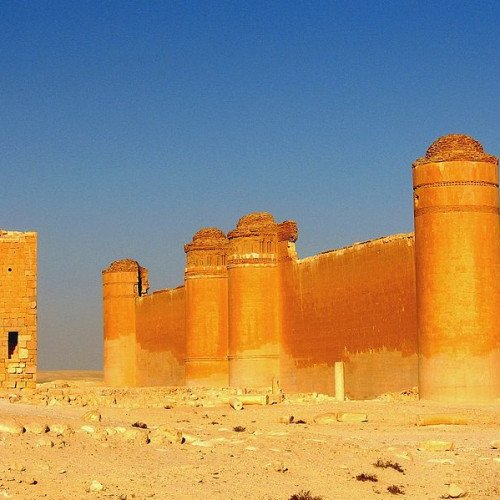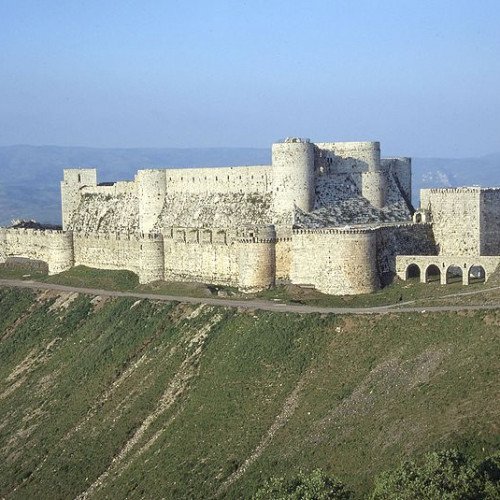Castles of "Syria" QASR AL-HAYR AL-SHARQI vs KRAK DES CHEVALIERS

QASR AL-HAYR AL-SHARQI
Qasr al-Hayr al-Sharqi (Arabic: قصر الحير الشرقي, lit. 'Eastern al-Hayr Palace or the "Eastern Castle"') is a castle (qasr) in the middle of the Syrian Desert. It was built by the Umayyad caliph Hisham ibn Abd al-Malik in 728-29 CE in an area rich in desert fauna. It was apparently used as a military and hunting outpost. The palace is the counterpart of Qasr al-Hayr al-Gharbi, a nearby castle palace built one year earlier. It is one of the so-called desert castles. Qasr al-Hayr al-Sharq is 27 kilometres (17 mi) from Al-Sukhnah and 100 kilometres (62 mi) from Sergiopolis (Rusafa), near Bishri Mountain near Palmyran Middle Mountains. Like other Umayyad architectural works, the construction style was influenced by Byzantine and Sasanian architectures. The palace consists of a large open courtyard surrounded by thick bulwarks and towers guarding the entrances as well as each corner. The palace consists of two square structures, one with a diameter of 300m and the other of 100 metres (330 ft). The palace(s) contains remnants of rooms, arches and columns which seem to be parts of a huge royal complex. Some of the decorated parts have been moved to the National Museum of Damascus while the gate has been reconstructed in the Deir ez-Zor Museum. The bigger palace has been several floors, with a huge gate and many towers. Towers were not built as defensive measures. There were also olive yards. The palaces were supplied with water by nearby Byzantine church by a canal 5,700 metres (6,200 yd) long. The palaces contained bathrooms, water reservoirs, mosques and gardens.
Statistics for this Xoptio

KRAK DES CHEVALIERS
Krak des Chevaliers or Crac des Chevaliers (French pronunciation: Arabic: قلعة الحصن, romanized: Qalʿat al-Ḥiṣn), also called Ḥiṣn al-Akrād (حصن الأكراد, literally "Fortress of the Kurds") and formerly Crac de l'Ospital, is a Crusader castle in Syria and one of the most important preserved medieval castles in the world. The site was first inhabited in the 11th century by Kurdish troops garrisoned there by the Mirdasids. In 1142 it was given by Raymond II, Count of Tripoli, to the order of the Knights Hospitaller. It remained in their possession until it fell in 1271. The Hospitallers began rebuilding the castle in the 1140s and were finished by 1170 when an earthquake damaged the castle. The order controlled a number of castles along the border of the County of Tripoli, a state founded after the First Crusade. Krak des Chevaliers was among the most important, and acted as a center of administration as well as a military base. After a second phase of building was undertaken in the 13th century, Krak des Chevaliers became a concentric castle. This phase created the outer wall and gave the castle its current appearance. The first half of the century has been described as Krak des Chevaliers' "golden age". At its peak, Krak des Chevaliers housed a garrison of around 2,000. Such a large garrison allowed the Hospitallers to exact tribute from a wide area. From the 1250s the fortunes of the Knights Hospitaller took a turn for the worse and in 1271 Mamluk Sultan Baibars captured Krak des Chevaliers after a siege lasting 36 days, supposedly by way of a forged letter purportedly from the Hospitallers' Grand Master that caused the Knights to surrender. During the Ottoman period (1516–1918), the Crac housed a company of müstahfızan (equivalent to local janissaries) and was the centre of the nahiye (tax district) of Hısnülekrad, attached first to the sancak (province) of Tripoli and later Homs. The castle itself was commanded by a dizdar (castle warden). Several Turkmen and Kurdish tribes were settled in the area and in the eighteenth century the district was mainly controlled by the Dandashli family of local notables. In 1894 the Ottoman government considered stationing a company of redif (auxiliary) soldiers there, but revised its plans after deciding the castle was too old and access too difficult. As a result the capital of the district was then moved to Tall Kalakh.